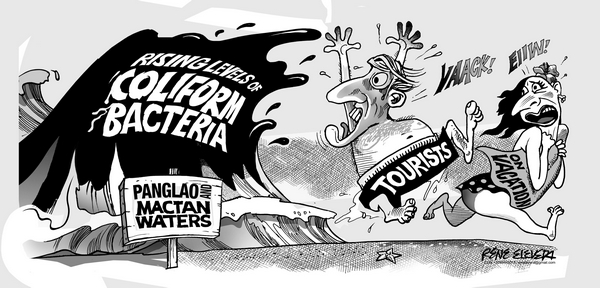
What were the factors that caused fecal coliform levels in the beaches of Mactan Island and Panglao Island in Bohol province to exceed past safe levels?
It also bears asking why the findings from the Environmental Management Bureau (EMB) on the fecal coliform levels in said areas came out only now, amid the ongoing evaluation and cleanup at Boracay Island whose closure diverted scores of tourists to the beaches of Mactan and Panglao.
Last Monday’s Cebu Daily News story showed that Lapu-Lapu City officials and representatives of the local hotel industry were caught unaware by the EMB findings that showed the fecal coliform level in the waters of Mactan reached between 107.96 and 5,777.5 most probable number (mpn) per 100 milliliter (ml) or higher than the safe level of 100 MPN per 100 ml.
The regional EMB office reportedly declared that most public beaches in Mactan were still safe to swim in and that their central office’s findings were based last year. Lapu-Lapu City Mayor Paz Radaza also shared the local EMB office’s opinion that there are beaches in the city area especially those operated by private entities that are safe for the locals and visitors.
Still while the EMB findings are alarming enough, we have yet to hear from local health authorities on any number of poisoning or health problems experienced by those who swam in these fecal coliform plagued beaches.
As far as information goes, the high fecal coliform level can be explained away by the EMB as caused by the lack of toilets by settlers that live near the coastline as well as piggeries built and operated near the sea.
The Lapu-Lapu City government should also double check on their inspections of their beaches and the hotels and resorts that operate near them to see if they do comply with health and safety standards set by law.
Far too often local officials find a convenient scapegoat in the settlers and blame them for causing much of the pollution that occurs in the coastline and either overlook or ignore possible violations committed by these hotels and resorts.
We hope the Hotels, Resorts, and Restaurants Association of Cebu (HRRAC) makes good on their commitment to fully cooperate with the EMB and the Lapu-Lapu city government in order to address the issue.
Though a closure is certainly not in the offing, Lapu-Lapu City and its residents need not wait for cases of skin infection and other health problems to occur before taking action.
It’s high time for both the city officials and stakeholders to double down on cleaning up their beaches and making sure it stays that way for both their locals and their visitors.